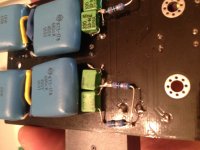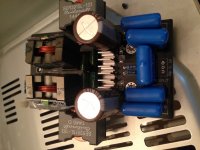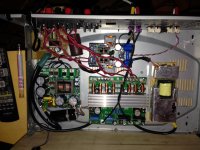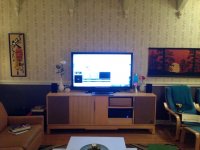For those wondering. On a BLT single supply amp like the TPA3116, peak current is just supply voltage divided with load impedance.
How come it's not then divided by two? I thought BTL was the reason there is two inductors per channel, so my (admittedly very naive understanding*) thinks that each inductor carries only half the current.
*Understanding is really too generous a term! 🙂
How come it's not then divided by two? I thought BTL was the reason there is two inductors per channel, so my (admittedly very naive understanding*) thinks that each inductor carries only half the current.
*Understanding is really too generous a term! 🙂
Inductors in series are common current, ie. all inductors in the series see the same current.
Inductors in Series and Series Inductor Circuits
Last edited:
Here's the current cAMP output inductor, the L versus current curve on page 2 is pretty damn sexy:10% Isat drop at peak current is probably acceptable but it's naturally better to have it flat to above the peak current output.
For those wondering. On a BLT single supply amp like the TPA3116, peak current is just supply voltage divided with load impedance. Although that overshoot the actual peak current slightly because it ignores switching losses, it's a good number for design and component choice purposes.
http://www.coilcraft.com/pdfs/ha4158.pdf
Previous inductor was DR127, with a 11.7 amp Isat. The OCL versus Isat curve (bottom of page 9) is flat to 50%, and is -10% at 80% of that:
http://www.cooperindustries.com/con...duct-datasheets/Bus_Elx_DS_4315_DR_Series.pdf
I'm pretty sure having the L change with the audio envelope causes nonlinearity/intermodulation, so I try to minimize delta-L as much as possible. Sadly I don't have access to to an Audio Precision set anymore or I'd be testing this sort of stuff.
Here's the current cAMP output inductor, the L versus current curve on page 2 is pretty damn sexy:
http://www.coilcraft.com/pdfs/ha4158.pdf
Previous inductor was DR127, with a 11.7 amp Isat. The OCL versus Isat curve (bottom of page 9) is flat to 50%, and is -10% at 80% of that:
http://www.cooperindustries.com/con...duct-datasheets/Bus_Elx_DS_4315_DR_Series.pdf
I'm pretty sure having the L change with the audio envelope causes nonlinearity/intermodulation, so I try to minimize delta-L as much as possible. Sadly I don't have access to to an Audio Precision set anymore or I'd be testing this sort of stuff.
Isn't part of the explanation for the difference that the dual inductors are measured in series while the single inductor is obviously stand-alone? Equal inductors in series have a much sharper roll-off after saturation as saturation happens at the same time. The combined result of two DR127s in series as used in a standard output filter will probably show a similar sharper roll-off while remaining totally flat slightly longer due to lower combined inductor losses. 2 single inductors in series will naturally not have as sharp a roll off as a dual inductor because the temperature rise would probably be lower even at higher combined losses due to having significantly more surface area to dissipate heat from.
Last edited:
The L versus current curves of both inductors assume 25C core temperature, you have to derate accordingly using the other curves/numbers in the datasheet for the application.
Slow roll-off versus brick wall is caused by differences in magnetic material and air gap design. A brick wall implies a high permeability material and a nice uniform air gap.
Slow roll-off versus brick wall is caused by differences in magnetic material and air gap design. A brick wall implies a high permeability material and a nice uniform air gap.
At the moment I have an Audiophonics TA2022 amp. I like it. Because of your posts about the SA60 and the good reviews of the SA60 elsewhere, I am considering buying a SA60 amp. Do you think it will be a major upgrade? Or, do you think the differences between the two are minor?
***
I have a TA2024 amp that I also like. However, I think the SA-60 offers advantages, including more power output, greater dynamic contrasts, and more detail. So I view the SA-60 as a step up from the T-amps. However, the T-amps still have a sweetness and smoothness, a natural musicality, to my ears, that few amps have, though the SA-60 is close. Think about it this way: you can stand five feet from an impressionist painting and see the individual paint dabs, or you can step back twenty feet and get the overall "impression" of the scene without seeing the individual paint elements. Which is better? It's up to each individual to decide.
Here is a list of inductor you can check out.
In increasing current rating at 10% drop.
COILCRAFT RFS1412 10uH 6.2A(10%L drop) RFS1412-103ME
WURTH WE-PD SMD 10uH 10.5A(10%L drop) 7447709100
SUMIDA CDEP 10uH 11.5A(10%L drop) CDEP147NP-100MC-125
COILCRAFT SER2900 10uH 13A(10%L drop) SER2915L-103KL
COILCRAFT SER2900 10uH 18A(10%L drop) SER2915H-103KL
WURTH WE-HCF SMD 10uH 22A(10%L drop) 7443631000
COILCRAFT SER2900 10uH 28A(10%L drop) SER2918H-103KL
WURTH WE-HCF SMD 10uH 34A(10%L drop) 7443641000
In increasing current rating at 10% drop.
COILCRAFT RFS1412 10uH 6.2A(10%L drop) RFS1412-103ME
WURTH WE-PD SMD 10uH 10.5A(10%L drop) 7447709100
SUMIDA CDEP 10uH 11.5A(10%L drop) CDEP147NP-100MC-125
COILCRAFT SER2900 10uH 13A(10%L drop) SER2915L-103KL
COILCRAFT SER2900 10uH 18A(10%L drop) SER2915H-103KL
WURTH WE-HCF SMD 10uH 22A(10%L drop) 7443631000
COILCRAFT SER2900 10uH 28A(10%L drop) SER2918H-103KL
WURTH WE-HCF SMD 10uH 34A(10%L drop) 7443641000
modded my first YJ Black
As a fan of tripaths I was somewhat slow to jump on the tpa3116 bandwagon. I thought the t-amps sound very good and there would be little room for improvement. Well I was wrong. At first with the crappy Jamicons the sound was very 2d and not lovely compared to a fully modded t-amp. So I put in some Nichicon Muses and that was really nice. Very detailed and clean, more detail than t-amps but not musical the way a nice t-amp is. Also the bass is just weak. I put in 3.3uf caps all way round but this did not improve the bass just the clarity. Then I replaced all the output caps. Next time I will do that last as I'm not sure I heard an effect. Next up were the boostraps. This helped with the dynamics and was definitely worth it. Next up the bootstrap snubbers. This tames the "edge" in the very top but in no way removes real detail. At this point it sounds very good but the bass is anemic. also, at loud volumes it sounds congested. So in go some Coilcraft inductors and now it is clean and sweet at "anger the wife" volumes. But it still is too thin sounding. So out with the muses and in with some Silmics. Eureka! this is it! Before the bass with the muses was there but it was like angelfood cake. Now with the silmics it is like a heavy, dense, sweet and delicious double fudge browny. The amp is completely silent, no buzz or hum in any way. The dynamics are to die for. I will try the Panasonics next time but I will be surprised if it is in any way better. The amp sounds so fast and detailed. There is nothing muddy or slow but at the same time it is sweet like honey and just sucks you in with a stupid grin on your face.
So Im putting it in a recycled Onkyo case and turning it into my theater amp with an old t-amp doing duties for the surrounds. Made a quick wood face for the amp and it sounds fantastic.
As a fan of tripaths I was somewhat slow to jump on the tpa3116 bandwagon. I thought the t-amps sound very good and there would be little room for improvement. Well I was wrong. At first with the crappy Jamicons the sound was very 2d and not lovely compared to a fully modded t-amp. So I put in some Nichicon Muses and that was really nice. Very detailed and clean, more detail than t-amps but not musical the way a nice t-amp is. Also the bass is just weak. I put in 3.3uf caps all way round but this did not improve the bass just the clarity. Then I replaced all the output caps. Next time I will do that last as I'm not sure I heard an effect. Next up were the boostraps. This helped with the dynamics and was definitely worth it. Next up the bootstrap snubbers. This tames the "edge" in the very top but in no way removes real detail. At this point it sounds very good but the bass is anemic. also, at loud volumes it sounds congested. So in go some Coilcraft inductors and now it is clean and sweet at "anger the wife" volumes. But it still is too thin sounding. So out with the muses and in with some Silmics. Eureka! this is it! Before the bass with the muses was there but it was like angelfood cake. Now with the silmics it is like a heavy, dense, sweet and delicious double fudge browny. The amp is completely silent, no buzz or hum in any way. The dynamics are to die for. I will try the Panasonics next time but I will be surprised if it is in any way better. The amp sounds so fast and detailed. There is nothing muddy or slow but at the same time it is sweet like honey and just sucks you in with a stupid grin on your face.
So Im putting it in a recycled Onkyo case and turning it into my theater amp with an old t-amp doing duties for the surrounds. Made a quick wood face for the amp and it sounds fantastic.
Attachments
5th blue capacitor is 1uF ? Solids esp FPNU but also wets Elna RJH and Chemicons have better detailed treble/cymbal than SilmicII. For bass PSU is also relevant. YJblack doesn't decouple/filter chip close enough. Output damping resistors have all kind of values on YJblack, if speakers are indeed 4-6ohm for high frequencies like your choice in output values suggests, replace the resistors for 3.3 ohm like TI.
For those wondering. On a BLT single supply amp like the TPA3116, peak current is just supply voltage divided with load impedance. Although that overshoot the actual peak current slightly because it ignores switching losses, it's a good number for design and component choice purposes.
So, the absolute maximum input voltage is 30 V, and the lowest impedance (PBTL) is 1.6 ohms, giving a worst-case peak current of 30/1.6 = 18.75 Amps. Right?
Perhaps a more realistic case, 26 V input (max TI recommended) and 3.2 ohm impedance (lowest in BTL mode) gives 26/3.2 = 8.125 Amps.
And maybe an even more common case, 24 V input, and 4 ohm speakers = 6 Amps.
So, the absolute maximum input voltage is 30 V, and the lowest impedance (PBTL) is 1.6 ohms, giving a worst-case peak current of 30/1.6 = 18.75 Amps. Right?
Perhaps a more realistic case, 26 V input (max TI recommended) and 3.2 ohm impedance (lowest in BTL mode) gives 26/3.2 = 8.125 Amps.
And maybe an even more common case, 24 V input, and 4 ohm speakers = 6 Amps.
Correct. Although since we're discussing peak figures, ie. worst case scenario, it might be prudent to use the minimum impedance or the dc resistance of the speaker instead of the nominal impedance. So a typical nominally 4 ohm driver would likely have a a minimum impedance in the 3.2-3.6 ohm range.
Please note that the generally maximum recommended voltage for the TPA3116 is 21V. Above that sound quality suffers significantly.
Has anyone heard the finished Breeze Audio TPA3116D2 2.0 channel amp? How did you think it sounded, stock and what is the potential for easy (I'm lazy!) mods to it? 🙂


How about the Mo-gu F900 (supposedly uses the TPA3110 chip):

Don't care about the bluetooth function, but perhaps it has something like the Sure TPA3110 board in there? Anyone know? 🙂
How about the Mo-gu F900 (supposedly uses the TPA3110 chip):

Don't care about the bluetooth function, but perhaps it has something like the Sure TPA3110 board in there? Anyone know? 🙂
Do you have a link for Mogu?
ebay 281473239132
seems like they use two tpa3110 in pbtl.
polymer caps might fit into that enclosure.
Last edited:
Has anyone heard the finished Breeze Audio TPA3116D2 2.0 channel amp? How did you think it sounded, stock and what is the potential for easy (I'm lazy!) mods to it? 🙂
seems it uses the same board as the one I pointed out in post #5659. It gives some of my valve and first watt amps a good run for their money...certainly the best of my 3 tpa3116 unmodded amps
seems it uses the same board as the one I pointed out in post #5659. It gives some of my valve and first watt amps a good run for their money...certainly the best of my 3 tpa3116 unmodded amps
Which other tpa3116 amps do you own?
Has anyone heard the finished Breeze Audio TPA3116D2 2.0 channel amp? How did you think it sounded, stock and what is the potential for easy (I'm lazy!) mods to it? 🙂
***
I have the Breeze 2.0 on order and will be comparing it with the SMSL SA-60 that I already have and like. After it arrives (week or two?) I'll post the results.
Which other tpa3116 amps do you own?
YJ blue and own brew 3116 on adapter board...admittedly the chip on adapter board is not unmodded but I havn't achieved the sound of the finished ebay amp yet.
- Home
- Amplifiers
- Class D
- TPA3116D2 Amp




